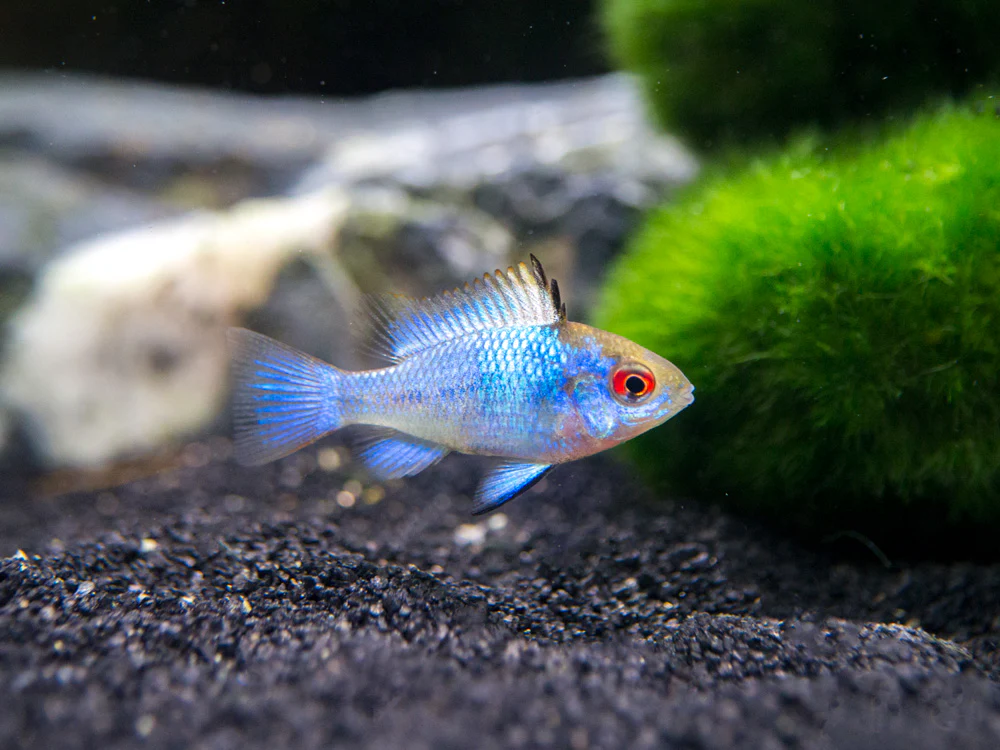The Electric Blue Ram, scientifically known as Mikrogeophagus ramirezi, is a vibrant and captivating freshwater fish that has gained popularity among aquarium enthusiasts. Known for its stunning electric blue coloration, peaceful demeanor, and manageable size, this fish has become a staple in the world of aquascaping and fishkeeping. This article delves into the origins, physical characteristics, habitat requirements, breeding behaviors, and care tips for the Electric Blue Ram, offering a comprehensive guide for both novice and experienced aquarists.
Origins and Natural Habitat
The Electric Blue Ram is a color morph of the Ram Cichlid, native to the Orinoco River basin in Venezuela and Colombia. In the wild, these fish inhabit slow-moving streams and rivers with warm, soft, and acidic water. They thrive in environments rich in vegetation and submerged roots, which provide ample hiding spots and breeding grounds. The Electric Blue Ram, however, is a result of selective breeding in captivity, enhancing its natural coloration to a more vivid blue, making it a sought-after addition to home aquariums.
Physical Characteristics
The Electric Blue Ram is renowned for its striking appearance. It features a compact and oval-shaped body, typically reaching 2-3 inches in length. The most distinctive attribute is its iridescent blue scales, which shimmer under aquarium lighting. This vibrant blue is complemented by occasional patches of gold and black, particularly around the head and dorsal fin. The fins themselves are often elongated and display a range of colors, adding to the fish’s overall allure. Males tend to be slightly larger and more colorful than females, with more elongated dorsal and anal fins.

Habitat Requirements
Creating an optimal environment for the Electric Blue Ram requires attention to several key factors. A minimum of 20 gallons is recommended for a pair of Electric Blue Rams. Larger tanks are preferable, especially if housing a community of fish, as it allows for more stable water conditions and ample swimming space. The ideal water temperature ranges between 78-85°F, with a pH of 5.5-7.0 and soft to moderately hard water. Consistency in water quality is crucial, as Electric Blue Rams are sensitive to fluctuations. A fine, sandy substrate mimics their natural habitat and is gentle on their delicate gills. Incorporate plenty of hiding spots using rocks, driftwood, and live plants like Java Fern and Anubias. These elements also help create territories and reduce stress. Use a gentle filtration system to maintain clean water without creating strong currents. Moderate lighting enhances their coloration and supports plant growth.
Diet and Feeding
Electric Blue Rams are omnivores with a preference for a varied diet. High-quality flake or pellet food should be supplemented with live or frozen foods such as bloodworms, brine shrimp, and daphnia. Providing a balanced diet not only promotes vibrant coloration but also supports overall health and longevity.
Breeding Behavior
Breeding Electric Blue Rams can be a rewarding experience, though it requires specific conditions and care. Rams typically form monogamous pairs. It’s best to start with a group of young Rams and allow them to pair off naturally. Provide flat stones or broad leaves where the female can lay eggs. The water should be slightly acidic (pH around 6.0) and soft, with a temperature near the upper end of their range (82-84°F). Both parents participate in guarding and fanning the eggs to ensure proper oxygenation. The eggs hatch in 2-3 days, and the fry become free-swimming after another 5-7 days. Parents continue to protect the fry, guiding them to food sources. Infusoria or commercially available fry food should be provided initially, transitioning to brine shrimp nauplii as they grow.
Compatibility and Tank Mates
Electric Blue Rams are generally peaceful but can become territorial during breeding. Suitable tank mates include other small, non-aggressive fish such as tetras, rasboras, Corydoras catfish, and small livebearers. Avoid housing them with larger, aggressive species that might bully or outcompete them for food.
Common Health Issues
Like all fish, Electric Blue Rams are susceptible to certain health issues, often related to water quality and diet. Ich (White Spot Disease) is a parasitic infection common in stressed fish. Treatment involves raising the water temperature and using appropriate medications. Hole-in-the-Head Disease, linked to poor water quality and vitamin deficiencies, can be prevented with regular water changes and a balanced diet. Good husbandry practices, including quarantine of new fish, can prevent bacterial and fungal infections.
Conclusion
The Electric Blue Ram is a stunning and rewarding addition to any freshwater aquarium. With its vivid colors, peaceful nature, and fascinating behaviors, it can be the centerpiece of a well-planned aquascape. By understanding its specific needs and providing optimal care, aquarists can enjoy the beauty and charm of this remarkable fish for years to come.









